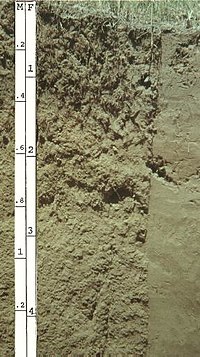Entisol
| Entisol | |
|---|---|
 Entisol profile showing little or no evidence of pedogenic horizon development | |
| Used in | USDA soil taxonomy |
Entisolsaresoils,as defined underUSDA soil taxonomy,that do not show any profile development other than anA-horizon(or “A” horizon). Entisols have no diagnostic horizons, and are unaltered from their parent material, which could be unconsolidated sediment, or rock. Entisols are the most common soils, occupying about 16% of the global ice-free land area.
Because of the diversity of their properties, suborders of entisols form individualReference Soil Groupsin theWorld Reference Base for Soil Resources(WRB):psammentscorrelate witharenosols,andfluventswithfluvisols.Manyorthentsbelong toregosolsorleptosols.Mostwassentsand aquic subgroups of other suborders belong to thegleysols.[1]
InAustralia,most entisols are known asrudosolsortenosols.
Causes of delayed or absent development[edit]
- Unweatherable parent materials –sand,ironoxide,aluminiumoxide, kaoliniteclay.
- Erosion – common on shoulderslopes;other kinds also important.
- Deposition – continuous, repeated deposition of new parent materials by flood asdiluvium,aeolian processeswhich means bywind,slope processes ascolluvium,mudflows,other means.
- Flooding or saturation.
- Cold climate – must not be sufficiently cold in winter forpermafrost.
- Dry climate.
- Shallow to bedrock – may be rock resistant toweathering,such asquartziteorironstone.
- Toxic parent materials –serpentine soil,mine spoils,sulfidicclays.
Suborders[edit]
- Aquents– heavily saturated or soaked soils, mostly present atriparianlocations (such as river banks, tidalmudflats,estuaries,etc). Here, consistent saturation limits development.
- Fluvents–alluvial soils,where development is prevented by repeated deposition ofsedimentduring periodicfloodingevents; present invalleysorriver deltas,especially those with high sediment load.
- Orthents– shallow or "skeletal" soils; found at sites of recenterosionevents, or very old landformscompletely devoid of weatherableminerals.
- Psamments– Entisols that are sandy (through all layers), and in which development is precluded by the impossibility of weathering the sand; formed from shifting orglacialsand dunes.
- Wassents– Entisols that have a positive water potential at the soil surface for more than 21 hours of each day, in all years.
Paleopedology[edit]
Mostfossilsoils, before the development of terrestrial vegetation in theSilurian,are entisols that show no distinct soil horizons. Entisols are common in thepaleopedological recordever since the Silurian; however, unlike other soil orders (oxisol,ultisol,gelisol,etc) they do not have value as indicators of climate. Orthents may, in some cases, be indicative of an extremely ancient landscape with very little soil formation (i.e., Australia today).
See also[edit]
References[edit]
- "Entisols".USDA-NRCS. Archived fromthe originalon May 9, 2006.Retrieved2006-05-14.
- "Entisols".University of Florida. Archived fromthe originalon September 18, 2004.Retrieved2006-05-14.
- "Entisols".University of Idaho. Archived fromthe originalon 2006-09-01.Retrieved2006-05-14.
- ^IUSS Working Group WRB (2015)."World Reference Base for Soil Resources 2014, Update 2015"(PDF).World Soil Resources Reports 106, FAO, Rome.
